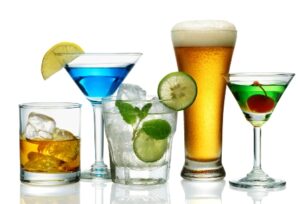
Alcohol is metabolized completely differently to other foodstuffs, which means that when alcohol is present in your body, calories from food and drink are not broken down as easily, which can cause weight gain.
When alcohol is consumed, as soon as it reaches your liver, it gets immediate attention from your digestive system. If you drink very quickly, your liver cannot process all of the alcohol in one go, leaving it to be dealt with by other bodily systems – hence the feeling of being drunk.
If you drink slowly, your liver can process the alcohol in one go, but as the liver is focussed on breaking down the alcohol, any carbohydrates or fat in the food or drink already present in your body cannot be broken down, meaning that the calories are not burned off or used as energy and are instead put into storage as fat.
Per gram, alcohol contains 7 calories. Sugary alcohols also contain fat – and alcohol contains no nutritional value. Alcohol can also lower your inhibitions – when you’re drunk, you can forget the diet plan pretty easily and you can find yourself reaching for a burger or a bag of chips instead of the salad you’d already planned on.
Research has actually shown that if you drink before or during a meal, your inhibitions and willpower are reduced, causing you to eat more than you would have if you’d had a bottle of water instead of a bottle of wine.
Wine and beer are the worst culprits in terms of calories and fat content – they also both contain carbohydrates. A bottle of wine or beer alongside your meal adds empty calories that will more than likely not get burnt off, so it’s best to wait until after your meal before having a drink. Whilst all alcohol is calorific, some alcohols are less calorific than others, making them a better choice for your weight loss efforts.
Lowest calorie drinks to choose
As a general rule, clear liquors such as vodka, gin and rum are the least calorific alcohols. Watch what they are served with, though – orange juice, full sugar coca cola or lemonade will all add empty calories.
Instead, opt for diet mixers such as diet soft drinks, soda water and ice to keep the calorie content low. Light beer is fairly low in calories, but is usually less alcoholic than darker beers. Long drinks such as a long island iced tea do have more calories than a glass of wine, for example, but they last longer and so you’ll probably drink less of them over the night.
Many cocktails contain lots and lots of calories and fat, too, but some cocktails are still fairly low in calories. Opt for cocktails such as martinis, mojitos, margaritas or whisky sours to keep the calorie count low – clear drinks made without sweetened mixers are generally the lowest in calories.
Steer clear of drinks such as pina colada or blue lagoon as these tend to contain sweet mixers such as fruit juice, cream or milk, which add calories and fat – or if you really want one of these cocktails, ask the barman to make your drink with skim milk instead of cream to cut some of the fat and calorie content. You’ll still get a creamy cocktail but with less of the calories.
Also make sure to drink a glass of water in between every alcoholic drink – you’ll feel much better for it in the morning and you’ll also take in less calories.
